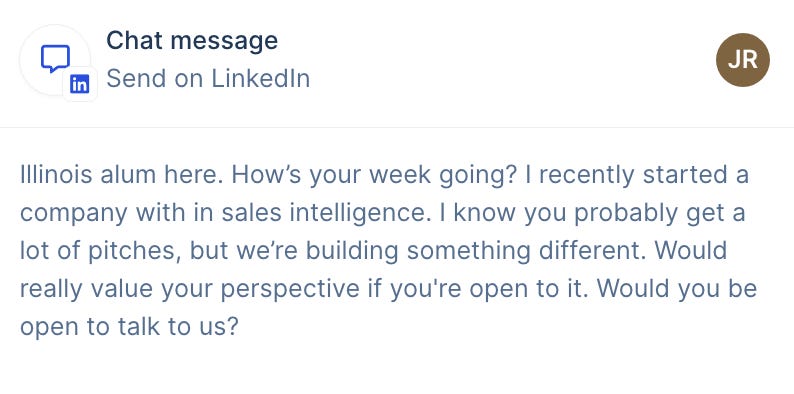Building Outbound from Scratch: A Founder’s Playbook
How the Salesmotion team turned cold outreach into a repeatable process that works
DEAR STAGE 2: We’re starting to build outbound for the first time and getting crickets. I don’t want to burn our TAM with bad messaging. What should we test and who should own this? ~ OUTBOUND OVERWHELMED
DEAR OUTBOUND OVERWHELMED: There’s a reason early outbound can feel like shouting into the void. You’re setting up systems, writing copy, sourcing leads, validating emails, and then trying to get all those parts to work in harmony. If it’s your first time building this muscle, hearing crickets is honestly expected.But the good news? Crickets don’t mean failure. They mean you’ve started. And now it’s time to iterate.
I spoke with Semir Jahic, Stage 2 LP and Co-Founder of Salesmotion, who recently built their own outbound engine from scratch. Their team hit the same early wall: “At the start our emails bounced, our copy was terrible, and we didn’t know who to go after.” But over time, they turned silence into signal.
Read on to hear how Semir built a successful motion by optimizing each part of that system, one step at a time.
Focus on Fit First
Before you write a single line of copy, lock in your target account list.
Semir and his team found traction by building lookalike lists: “We have a few case studies, we find 5-10 similar companies via Google, ChatGPT, or Ocean.io.” This grounds your list in companies that already map to your strengths and keeps your TAM tight enough to personalize without sounding robotic.
If your TAM is small, resist the urge to spray-and-pray. “Our lists are tight, just a few hundred people, so anyone reading it feels like it’s personalized based on industry/title/pain,” Semir said.
That balance between relevance and scale matters more than clever copy.
Invest in Deliverability Before Messaging
Even the best copy doesn’t matter if it never hits the inbox. “Only once you have valid emails and infrastructure that can deliver email to inboxes can you properly start to test messaging and plays,” Semir explained.
What does that look like?
Use tools like FullEnrich to validate emails.
Warm up your domains and mailboxes with providers like Smartlead, Salesforge or Lemlist.
Keep email volumes low while testing to avoid deliverability issues.
A 1–3% positive reply rate might not sound high, but when that means real responses (even “not interested”), it’s a signal your emails are landing and that your infrastructure is working.
Experiment and Track Progress
Outbound is equal parts creativity and discipline. The best messaging play isn’t the one that sounds best, it’s the one that actually works. “This is quite hard being an early stage company where multiple pain points and features and value propositions can resonate with different buyers,” Semir noted. That’s why you need to test your emails scientifically, in small batches, with defined personas and hypotheses.
Steal This: Semir limits himself to a max of 10 emails per inbox per day and applies best practices for deliverability like using Spintax, meaning variation of text so emails don’t look the same and are less likely to get flagged as spam. It’s like mail merge to look human e.g. [Best|Regards|Kind Regards|Best Regards] spread across your email. One of his favorites? Try [AEs|reps|sellers|account execs|account executives]
“You’d think the play of ‘We went to the same university’ is completely outdated,” Semir shared. “Turns out, the reply rates are amazing, to date 20%+ and many positive ones in there.” A simple LinkedIn search filtered by persona and University led to Salesmotion finding 800 relevant alumni that they simply message starting with “Illinois Alum Here.”
The learning? Don’t believe LinkedIn or advice online, test it for yourself.
Add a Layer of Warmth
Not everything has to be cold. In fact, blending outbound with intent-based triggers from LinkedIn, news, hiring or other relevant activity can create a pipeline of “warm outbound” leads. Semir is an active poster on LinkedIn and shared that he checks every profile visit manually and adds ICPs into a follow-up campaign. Feels like a lot of work, but he explained that every sliver of intent can be used to engage and build pipeline.
The trick is to be human: ‘pitch-slapping’ (IFYKYK) on LinkedIn won’t work. But soft touches, thoughtful engagement, and content-driven outreach can move prospects into your funnel without burning your brand. One of the key sources of inspiration for Semir on this topic is Samantha McKenna from SamSales. Her “Show Me You Know Me” is the gold standard. While not always possible to go so deep, it’s what we should aspire to do in our outreach.
Who Owns It? You Do…for Now
In the early stages, outbound is a founder’s job. Simple as that.
“It’s where you figure out message-market-fit,” Semir emphasized. You’re not just writing emails, you’re learning what makes your market tick. As you grow, this can be owned by a jack-of-all-trades GTM hire or RevOps lead. But for today, embrace the role. The learning loops you build today will shape your future GTM motion.
Until next week!





Thanks so much for featuring us in this edition Liz. It was a pleasure to collaborate with you on this one!
Hey Liz, thanks for sharing this. I just graduated and have been working on an AI code documentation tool but I've been struggling on outbound majorly. Given you obviously know what you're talking about, would you be willing to talk or answer a few more specific questions? hjconstas@docforge.net